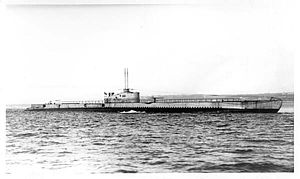 The Redoutable-class Ajax, circa 1930
| |
| Class overview | |
|---|---|
| Name | Redoutable class |
| Operators | |
| Subclasses |
|
| Completed | 31 |
| Lost | 26 |
| Retired | 5 |
| General characteristics | |
| Type | Submarine |
| Displacement | |
| Length | 92.3 m (302 ft 10 in) |
| Beam | 8.2 m (26 ft 11 in) |
| Draught | 4.9 m (16 ft 1 in) |
| Installed power | |
| Propulsion |
|
| Speed |
|
| Range |
|
| Test depth | 80 m (260 ft) |
| Complement |
|
| Armament |
|
The Redoutable-class submarines were a group of 31 submarines built between 1924 and 1937 for the French Navy. Most of the class saw service during the Second World War. The class is also known in French as the Classe 1 500 tonnes, and they were designated as "First Class submarines", or "large submarine cruisers". They are known as the Redoutable class in reference to the lead boat Redoutable, in service from 1931 to 1942. The class is divided into two sub-class series, Type I, known as Le Redoutable and Type II, Pascal.
Although these were modern submarines when they were designed, they quickly became outdated and were approaching obsolescence by the beginning of the Second World War. The conditions of the Armistice of 22 June 1940 prevented the Vichy government from carrying out a modernization programme. 24 out of the 29 units that served in the war were lost. Used in the defence of the Second French colonial empire under the Vichy regime, submarines of the class saw action against Allied offensives at the Battles of Dakar, Libreville and Madagascar. Many of the submarines of the class came under Allied control after the Allied landings in North Africa. Few however saw much further active service after this due to a period of refitting and alterations done in the United States between February 1943 and March 1945. One exception was Casabianca, which took part in the liberation of Corsica. The surviving submarines were largely used for training purposes after the war, with the last of them being disarmed in 1952.